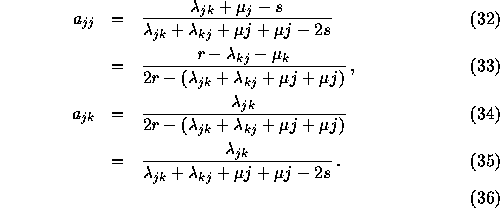At each age, tables such as table 1, provide 4 independent
ratios, ![]() , i,j=1,2. If we assume that the 4 unknown
forces are constant during
, i,j=1,2. If we assume that the 4 unknown
forces are constant during ![]() , we may estimate these forces.
T is the interval between two rounds, i.e. about 2 years.
, we may estimate these forces.
T is the interval between two rounds, i.e. about 2 years.
Matrix ![]() from equation 1 can be diagonalized; the
eigenvalues are the roots of equation:
from equation 1 can be diagonalized; the
eigenvalues are the roots of equation:
![]()
Since:
![]()
,
this equation leads to 2
distinct real and negative roots, ![]() and
and ![]() , r>s, where:
, r>s, where:

Therefore, ![]() , or the probability for an individual in
state j at time 0 to be in state k at time t, can be written:
, or the probability for an individual in
state j at time 0 to be in state k at time t, can be written:

Constants are determined by initial conditions at time 0:

and by conditions which derivates at time 0 must satisfy:

This leads to:

Since ![]() , the expression
can also be written:
, the expression
can also be written:

If ![]() corresponds to the (
corresponds to the (![]() ) matrix with element
) matrix with element
![]() , it can be written
, it can be written![]() :
:
![]()
As ![]() is known from the LSOA survey for each single age, this
leads to a system of four equations with four unknowns,
is known from the LSOA survey for each single age, this
leads to a system of four equations with four unknowns,
![]() ,
, ![]() ,
, ![]() and
and ![]() .
.
For the numeric calculations we used IMSL dneqnf subroutine.
As T is about 2 years, we can either use single age or double age
(x, x+2) estimates.